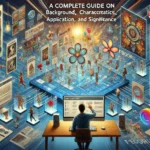Introduction To influncersgonewild
Influencers have hitherto unheard-of power in the era of social media rule. Millions of people follow these digital stars on their every post, therefore influencing trends, way of life, and even perspective. Some influencers have crossed the line, though, as the competition for clicks and clout gets more fierce—partaking in hazardous stunts, endorsing negative content, or igniting indignation with ethically dubious behaviour. Often referred to as influncersgonewild, this phenomena exposes a concerning underbene of influencer culture via popular searches.
Examining real-life scandals, legal consequences, ethical conundrums, and the larger social repercussions, this piece delves deeply into the anarchy of influencers gone crazy. Whether your job is marketing or casual scroller, knowing this trend can help you negotiate the digital terrain of today.
From aspiration to excess, influencer culture is rising.
We should know how we got here before we start to break out the anarchy. Along with sites like Instagram, YouTube, and TikHub, influencer culture developed where regular people could gather followings on par with established celebrities. Companies grabbed hold fast, paying influencers to advertise lifestyles, travel locations, and goods and services.
But desperation developed along with competitiveness.
Algorithms reward engagement—whether positive or negative—pushing creators to extremes. A harmless prank or a curated “perfect life” post no longer cuts it. Instead, influencers now resort to shock value, controversy, and even illegal acts to stay relevant.
When Influencers Cross the Line: Notorious Examples of “Influncersgonewild”
1. Risky Stunt and Public Nuisances
After live-streaming himself ascending a 50-story tower without safety gear in 2023, a TikToker was charged criminally. Another influencer set off panic by staging a fictitious heist in a packed mall. These acts jeopardise public safety and squander law enforcement resources, therefore they are not only reckless.
Why it matters? Especially for younger viewers, such antics help to normalise risk-taking behaviour. Ignorant of the legal or bodily repercussions, followers could copy these activities.
2. Exploitative Content and Cultural Insensitivity
Critics of influencers using poverty, sorrow, or underprivileged cultures as backgrounds for photo opportunities have pointed out One travel blogger, for example, drew criticism for gleefully standing before a Syrian refugee camp. Others have borrowed holy customs or stereotypes for “aesthetic” value.
The Ethical Dilemma: This reduces human suffering or cultural heritage to mere props, prioritizing engagement over empathy.
3. Promoting Harmful Products or Misinformation
From anti-vax conspiracies to laxative beverages sold as weight-loss remedies, influencers often blur the boundary between opinion and reality. Unverified promises of “miracle cures” by a wellness influencer in 2022 resulted in hospitalisations and litigation.
Legal Implications: Although enforcement is still uneven, regulatory agencies like the FTC increasingly demand unambiguous disclaimers for sponsored articles.
Legal Consequences: Influencers Under Law
Legal Implications: Regulatory bodies like the FTC now require clear disclaimers for sponsored posts, but enforcement remains patchy.
Legal Repercussions: When Influencers Face the Law

The influncersgonewild trend isn’t just morally fraught—it’s increasingly landing creators in court.
1. FTC Violations and Fraud
The Federal Trade Commission (FTC) has cracked down on influencers who hide paid partnerships or make false claims. In one case, a beauty influencer was fined $1 million for promoting a skincare line she secretly owned without disclosure.
2. Criminal Charges
From trespassing to assault, influencers are being held accountable. A YouTuber notorious for “prank” videos was charged with battery after a staged attack caused real injury.
3. Intellectual Property Battles
Using logos, photos, or copyrighted music without authorisation has resulted in takedown notifications and legal action.Smaller creators often lack the legal knowledge—or budget—to navigate these issues.
Ethical Quandaries: The Gray Areas of Influencer Behavior
Not all influncersgonewild scandals are illegal, but many raise ethical red flags:
- Privacy Violations: Filming strangers in public without consent, especially in vulnerable moments (e.g., homeless individuals).
- Environmental Damage: Think influencers trampling protected ecosystems for the perfect shot or leaving trash at viral locations.
- Mental Health Exploitation: Sharing intimate details of personal struggles (breakups, addiction) for sympathy-driven engagement.
The Impact on Followers: Why “Wild” Content Harms Audiences
- Influencers pursue virality, yet their acts have practical effects:
- Normalising Risky Behaviour: Teens doing challenging tasks (like the “Tide Pod Challenge”) frequently cite influencer videos as motivation.
- Eroding Trust: Staged content exposes their followers, hence inspiring scepticism.
- cynicism.
- Mental Health Toll: Curated perfection and outrageous behavior alike contribute to anxiety, FOMO, and low self-esteem.
Navigating the Future: Solutions for a Healthier Influencer Ecosystem
1. Platform Accountability
Social media companies must prioritize safety over engagement. Algorithms should downrank harmful content, and stricter verification processes could deter fake accounts.
2. Creator Education
Influencers need training on legal guidelines (e.g., FTC rules) and ethical storytelling. Agencies and platforms could offer certification programs.
3. Audience Awareness
Followers must think critically: Is this content authentic? Could it harm others? Media literacy education in schools can empower younger users.
4. Legal Reform
Laws to control influencer marketing, demand disclaimers, and punish false information are being development by governments all around.
Conclusion
The influncersgonewild trend reflects the darkest side of our digital society, not only a sequence of viral fails. Although influencers answer for their behaviour, platforms, brands, and audiences also help to keep this loop running. Promoting openness, responsibility, and empathy will help us to transform influencer culture into a tool for good.









